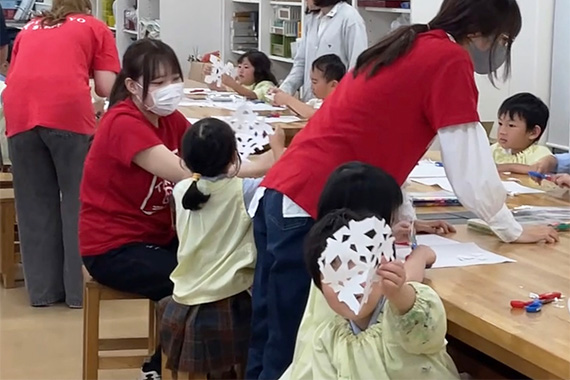
- 八王子キャンパス
帝京大学短期大学 人間文化学科

- 八王子キャンパス

個性を生かす少人数教育で
グローバル化に対応する能力と
伝統に対する知識を身につけます
グローバル化した現代社会で活躍するための英語力、日本の伝統に対する知識修得と継承への意欲を高める書道、人間社会や心理に関する研究の基本を中心に、進路選択の可能性を広げる領域を設置しています。カリキュラムは一人ひとりの個性を生かす少人数教育を徹底しており、社会ですぐに役立つ基本スキルを身につけます。

考えながら行動することで、柔軟な対応力をマスター
「芸術と社会貢献」の授業では、隣接する幼稚園とコラボレーションしたワークショップを行い、社会に出た時に汎用性ある能力のスキルアップをめざします。スライムやクレパスなど、子どもたちが関心のあるものを応用して、園児と学生が一緒にアート作品を制作。授業では、実際に手を動かしながらどのような方法、道具を取り入れると子どもたちが楽しく取り組めるかを考察します。ワークショップでは、臨機応変な対応力、年齢が異なる対象者へのコミュニケーション力が身につくほか、子どもたちからは物事を新しい視点を感じながら多くのことを学びます。これらにより、ともに学び合うサイクルが作られます。
TOEIC®テストをオンラインで実施
人間文化学科の英語授業の一環として、TOEIC Bridge® Listening & Reading IPテストとTOEIC® Speaking & Writing IPテストを実施しています。自身の英語力を知るだけでなく、目標を持って英語学習に取り組んでもらうねらいがあります。アンケートでは、受験した学生のうち1年次では93.5%、2年次では83.3%が「自分の英語力を確認するのに役に立った」と答えています。また1年次では61.3%、2年次では50.0%が「TOEIC®に対する興味が増えた」と答えています。
英語とライフデザイン演習、基礎演習を必修科目とし、多彩な選択科目と合わせ、系統立てて履修できるカリキュラム構成です。各自の関心と興味を将来のキャリアデザインと関連づけ、主体的に学ぶことを重視しています。帝京大学文系学部の開設科目の一部をオープンカリキュラムとして履修することもできます。
英語コミュニケーション
人間文化学科の7つの学びの軸のうち、「異文化理解」を図るために行われているのが、英語コミュニケーションの授業です。この日のテーマは映画。まず、“Mr.ビーン”のDVDを字幕なしで視聴したあと、教室全体で大まかなストーリーを共有します。さらに、対話の音声のみを聞いて、表現を口に出して覚え、先生や学生同士でテーマに関連する質問をし合うことで、生きた英語をものにしていきます。授業はネイティブスピーカーである先生のもと、すべて英語で展開。その理由を聞いたところ、「Practice makes perfect.(習うより慣れよ)」。実際に、はじめは戸惑っていた学生も次第に耳が慣れ、自然に会話できるようになっていく。国際社会への第一歩を踏み出すための大切な授業です。
心理学研究の実践
みなさんは心理学について、どのようなイメージを持っていますか?心理学を勉強したら人の心を読めるかも、というHow to的なものを期待していませんか?実際には、そう簡単なものではありません。本授業では実際の心理学研究を丸ごと取り上げ、どのような問題意識から、どのような方法が用いられ、どのような結果が得られ、どのように結論づけられたのか、といった一連の心理学研究の流れを講じます。私たちが日頃、疑問に思っていることを心理学的に追究するにはどうしたらよいのか、というように「研究者の立場」で心理学という学問に触れていきます。このような心理学的なものの見方を身につけることによって、偏見なく物事を深く考えることができるようになることをめざしています。
キャリアとライフデザインの心理
みなさんは歴史上の人物の伝記を読んだことがありますか?少年少女向けの偉人伝ではなく、正確な歴史に基づいた伝記です。そこには歴史に名を残した偉人の姿よりも、むしろ、私たちと同じひとりの人間の心の葛藤があります。本授業では伝記資料を用い、歴史上の人物の人生を通して、人間の一生をアイデンティティ理論から考えていきます。他者を理解しようとする際に、その人のアイデンティティを理解することは重要なポイントになります。なぜならアイデンティティは私たちの態度・行動・感情などに一貫性を与えているからです。アイデンティティ理論によって歴史上の人物の態度・行動・感情がより深く理解できるとともに、具体的な歴史上の人物の生き様がアイデンティティ理論を生き生きとしたものにしてくれます。アイデンティティがより身近なものになる授業です。
恋愛と結婚の心理学
「恋愛や結婚についてお聞かせください」と言われたら、人はこれまでの人生経験から自分の恋愛観や結婚観について、いくらでも話すことができるのではないでしょうか。それくらい恋愛や結婚は身近なものであり、また個人の価値観を含んでいるので非常にデリケートなものでもあります。本授業では、個々の価値観に踏み込んでいくのではなく、何が人間にとって幸せなのか、またその幸せの状態を維持していくためにどうしたらよいのかについて、アイデンティティ理論からアプローチしていきます。「キャリアとライフデザインの心理」では主にアイデンティティとキャリアが中心ですが、本授業ではアイデンティティと対人関係を中心に論じていきます。
絵画
受講している学生はさまざまですが、想いは一緒で「絵を描いてみたい」です。いろいろな物をよく観察することから始め、デッサンの基本となる鉛筆の削り方や紙の選び方、物を描くときの基本となる姿勢やコツなども制作を通じて学びます。本授業では表現技術の習得だけを目標としていません。物を描くということは視野を時にはミクロ、時にはマクロにして物を認識して表現するということです。物を観察する習慣や日常生活においてさまざまな現象に気がつくきっかけとなります。物をよく観察して認識したものを表現することには、さまざまな学びがあります。そして、何より美しいものに敏感になります。
芸術と社会貢献
「芸術と社会貢献」という科目名は少し堅いイメージですが、通称は「ゲイシャ(芸社)」と呼ばれています。隣接している帝京大学幼稚園に出向き、園児と制作のワークショップを行います。(名付けて「わくわくワーク」)本授業では自分たちの考えたワークショップを計画、実践していきます。制作を介在させることによって、園児には「制作の喜びと楽しさ」学生と幼稚園教諭、授業者に「共に学び、気づき」が生じる学びのサイクルを作ります。半期で4回のワークショップを展開していきます。教員志望や教育学部編入を考えている学生には現場を経験する貴重な場となります。
版画
表現は面白く楽しいものです。そして、楽しいだけでなく学びがあります。パソコンや携帯・スマートフォンの普及により、物を液晶画面で確認することが多くなりました。この現象は、物の実在感を感じる機会が極端に少なくなり、現代社会においてさまざまな問題の起因となっています。積極的、意識的に手作業によるものづくりを経験することは現代だからこそ必要です。本授業は用具材料の扱いから始め、簡単な版の制作をします。作業をしながら自分の表現を探します。これらを通じて物の実在感を再確認し、表現することの喜びを味わい、自分を表現することを学びます。作品の完成の達成感は普段の生活では味わえないものです。
書道文化概論
日本文化のなかに見られる書と文字の関連について、さまざまな視点から考えていく科目です。漢字を日本語の表記として使い始めた古代から、近代の書道文化まで、現代に受け継がれている書と文字の文化を広く学ぶことができます。こうした、日本の書道文化は、日本文学や歴史学、美術史学、書道史学など関連するさまざまな学問分野へと広がる可能性を秘めています。授業では、関連する参考資料や、数百年前の実物の書跡資料を活用して、日本の伝統文化と書のつながりを専門的に学ぶことができる科目となっています。
名跡鑑賞
歴史的に高く評価されてきた書の名跡について、その歴史や鑑賞の方法を分かりやすく学びます。現在、国宝や重要文化財に指定されている書跡や典籍は、日本国内に約2,000件あります。また、指定品以外でも名跡として高く評価されている作品が多く残されています。こうした名跡とされる日本の書跡資料を鑑賞する場合、具体的な鑑賞のポイントや書いた人物、制作背景などを知ることで、より深い鑑賞につなげることができます。美術館や博物館で目にする各時代の有名な書跡や、かつて名跡として尊重された歴史を持ちながら、現代では高く評価されない資料など、各時代の人びとによる名跡観の変遷についても考える授業です。
児童文字教育研究(板書技法)
板書による書字は学校教員の基礎的なスキルであり、特に小・中学校における、教員の板書の重要性は極めて高いと言えるでしょう。手書きによって的確に書字する能力は各教科指導の基盤となるものであり、また各教育現場において授業中の教員の板書は生徒達の学習理解度に大きく影響を与えます。本授業では、「書道文化」とのかかわりから、学校での教授における板書力の育成をめざしています。学生にとって身近な存在である板書を通して、文字を正確に理解し適切に書写する能力を育てるとともに、文字感覚を養い、文字に対する関心を深めることをめざします。漢字・仮名文字の書字原理を学び、縦書き・横書きでの正しく整った美しい表記ができる基礎力を身につけます。
GPA(Grade Point Average)制度の導入の趣旨は、1. キャンパスとして統一した基準を作成すること、2. 公平性に優れた基準であること、3. 国際的に通用する基準であることとし、学生の学修の成果をGPAという客観的な数値で評価するものです。またこの制度は、欧米の大学で採用されている成績評価制度に概ね準拠しており、海外留学、海外の大学院進学、外資系企業への就職などの際に学力を証明する指標として、海外でも通用する成績評価制度となっています。
| 区分 | 評価 | GPA | 成績評価基準 | 評価内容 | (英文内容) |
|---|---|---|---|---|---|
| 合格 | S | 4.0 | 90点以上 | 特に優れた成績を表します。 | (Excellent) |
| A | 3.0 | 80点台 | 優れた成績を表します。 | (Good) | |
| B | 2.0 | 70点台 | 妥当と認められる成績を表します。 | (Satisfactory) | |
| C | 1.0 | 60点台 | 合格と認められる最低限の成績を表します。 | (Pass) | |
| 不合格 | D | 0.0 | 60点未満 | 合格と認められる最低限の成績に達していないことを表します。また、授業等の出席日数不足および当該授業における試験の未受験等も含みます。 | (Failure) |
| 対象外 | N | - | - | 編入や留学等により他大学等で修得した科目を本学の単位として認定したことを表します。(単位認定科目) | (Credits Transferred) |

| 科目の種類 | 必修・選択の別 | 卒業要件単位数 | ||
|---|---|---|---|---|
| 総合基礎科目 | Ⅰ:大学での学び方 Ⅱ:人の心と思想を学ぶ Ⅲ:歴史と文化を学ぶ Ⅳ:社会と経済のしくみを学ぶ Ⅴ:法律と政治のしくみを学ぶ Ⅵ:自然法則と数理科学を学ぶ Ⅶ:地球環境と生命科学を学ぶ | 選択 | 12 | |
| 専門教育科目 | 必修科目 | 必修 | 16 | 50 |
| 選択必修科目 | 選択必修 | 12 | ||
| 選択科目※ | 選択 | 22 | ||
| 合計 | 62 | |||
専門教育科目について